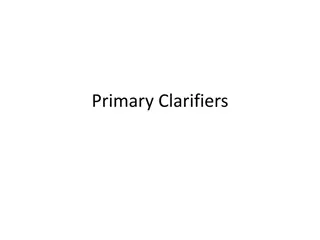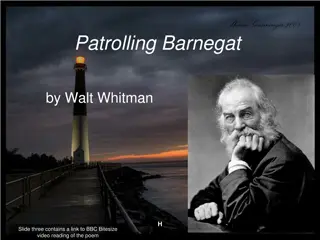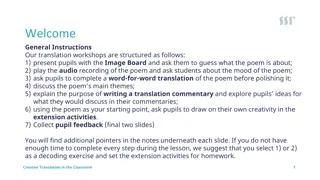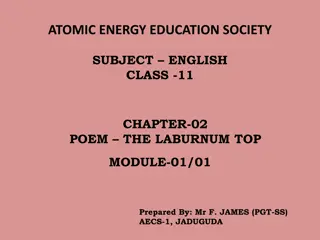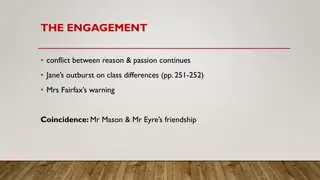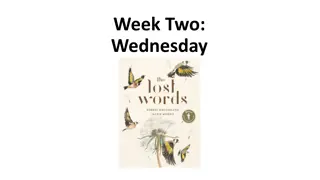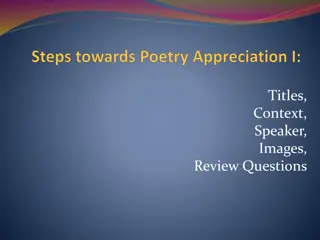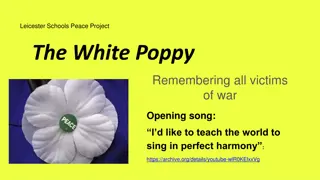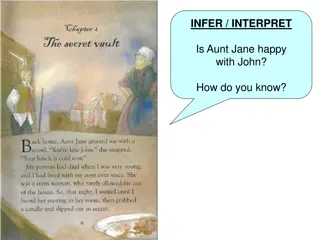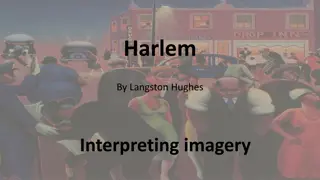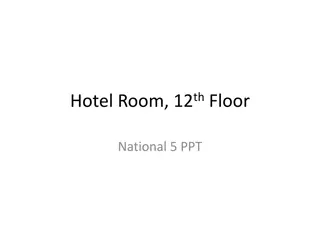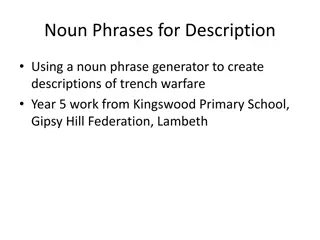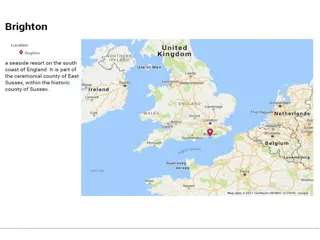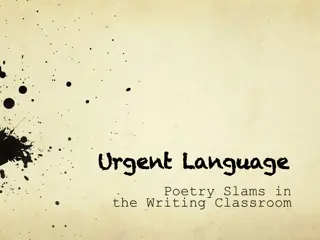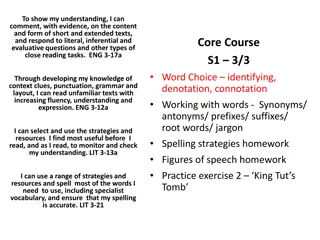Exploring Connotations of Poppies in Jane Weir's Poem
The content delves into the associations and connotations typically linked with poppies, focusing on Jane Weir's modern poem "Poppies." It discusses the significance of the poppy in remembrance, weaving together historical context and the poet's personal aims in capturing the theme of loss and parenting. Tasks and discussions encourage analysis of language, structure, and themes within the poem to deepen understanding.
Download Presentation

Please find below an Image/Link to download the presentation.
The content on the website is provided AS IS for your information and personal use only. It may not be sold, licensed, or shared on other websites without obtaining consent from the author. Download presentation by click this link. If you encounter any issues during the download, it is possible that the publisher has removed the file from their server.
E N D
Presentation Transcript
AQA POWER AND CONFLICT POETRY POPPIES BY JANE WEIR
YOUR TASK What do we usually associate with poppies? What are the connotations of a poppy?
YOUR TASK: CONTEXT Key Idea Key Idea The poem Poppies is a modern poem but draws upon the idea of the poppy flower that has become synonymous with remembrance. The poem is set in the present day but flashes back to the origins of the poppy as a symbol of remembrance at the end of World War One Armistice Sunday. Jane Weir also runs her own textile business and often weaves some of those ideas into her own writing. Armistice Sunday is still used to remember and honour any soldiers who have died in the line of duty. Focus is on remembrance Key Idea Key Idea Summary Today s key questions: 1. Can I read, understand and respond to the text? 2. Can I analyse language and structure, explaining WHY the writer has used a particular technique and its effect? 3. Can I discuss the social and historical context of the poem?
ORACY TASK MAKING INFERENCES Consider what you already know about the poem. Now look at the pictures. On your tables, discuss what ideas and themes you think will be explored in the poem. See if you can come up with FOUR ideas. Be prepared to share your thoughts. Today s key questions: 1. Can I read, understand and respond to the text? 2. Can I analyse language and structure, explaining WHY the writer has used a particular technique and its effect? 3. Can I discuss the social and historical context of the poem?
JANE WEIRS AIMS "I wanted to write a poem from the point of view of a mother and her relationship with her son, a child who was loved cherished and protected and it had led to this . heightened and absolute fear that parents experience in letting their children go, the anxiety and ultimately the pain of loss I hoped to somehow channel all this, convey it into something concise and contemporary, but also historically classic, in terms of universal experience." Today s key questions: 1. Can I read, understand and respond to the text? 2. Can I analyse language and structure, explaining WHY the writer has used a particular technique and its effect? 3. Can I discuss the social and historical context of the poem?
YOUR TASK: LANGUAGE BY LINE You have been given a line from a poem. Circle or highlight key words that you think are important. Label them with the correct subject terminology. Write down the connotations of your words. What does it suggest to you? Now share your line and connotations with your partner. Has this task proven your previous inferences correct or incorrect? How? Why? Decide what the poem is going to be about and be prepared to share your ideas. Today s key questions: 1. Can I read, understand and respond to the text? 2. Can I analyse language and structure, explaining WHY the writer has used a particular technique and its effect? 3. Can I discuss the social and historical context of the poem?
POPPIES BY JANE WEIR Three days before Armistice Sunday and poppies had already been placed on individual war graves. Before you left, I pinned one onto your lapel, crimped petals, spasms of paper red, disrupting a blockade of yellow bias binding around your blazer. slowly melting. I was brave, as I walked with you, to the front door, threw it open, the world overflowing like a treasure chest. A split second and you were away, intoxicated. After you d gone I went into your bedroom, released a song bird from its cage. Later a single dove flew from the pear tree, and this is where it has led me, skirting the church yard walls, my stomach busy making tucks, darts, pleats, hat-less, without a winter coat or reinforcements of scarf, gloves. Sellotape bandaged around my hand, I rounded up as many white cat hairs as I could, smoothed down your shirt s upturned collar, steeled the softening of my face. I wanted to graze my nose across the tip of your nose, play at being Eskimos like we did when you were little. I resisted the impulse to run my fingers through the gelled blackthorns of your hair. All my words flattened, rolled, turned into felt, On reaching the top of the hill I traced the inscriptions on the war memorial, leaned against it like a wishbone. The dove pulled freely against the sky, an ornamental stitch. I listened, hoping to hear your playground voice catching on the wind.
YOUR TASK: SUMMARISE Re-read the poem in silence. Next to each stanza, summarise what is happening. Today s key questions: 1. Can I read, understand and respond to the text? 2. Can I analyse language and structure, explaining WHY the writer has used a particular technique and its effect? 3. Can I discuss the social and historical context of the poem?
YOUR ANALYSIS Spend TEN minutes making independent annotations on your copy of Poppies . What is the significance of the structure? As you annotate, write down any questions that come to mind. We will answer these later. MEANING IMAGERY TONE STRUCTURE LANGUAGE Today s key questions: 1. Can I read, understand and respond to the text? 2. Can I analyse language and structure, explaining WHY the writer has used a particular technique and its effect? 3. Can I discuss the social and historical context of the poem?
ANALYSING POPPIES What is the tone of this first stanza and how is it established in the opening line? Why does the mother pin the poppy on her son? Why does the son not do it himself? Why does the poet specify individual war graves ? Highlight all the examples of the caesura in the poem. The speaker is the mother of a son who has gone to war. Why has the poet used caesura? What are the connotations of a blazer ? How is the poet trying to present the speaker s son at this point? How does the speaker view her child? Three days before Armistice Sunday and poppies had already been placed on individual war graves. Before you left, I pinned one onto your lapel, crimped petals, spasms of paper red, disrupting a blockade of yellow bias binding around your blazer. Bias , in this context, is a direction diagonal to a weave of fabric. (A slant). Highlight all the references to fabric and textiles in the entire poem. Why include these? Spasms , disrupting and blockade are negative word choices. Why has the poet used them? What could they symbolise? The time frame of the poem is ambiguous. It s not certain when exactly these events are taking place. Is this a mother sending her son off to the army or off to school? Why create this uncertainty?
ANALYSING POPPIES The speaker is trying to remember a tender moment with her son. How does bandaged destroy this positive image? What device has been used in blackthorns of your hair ? What are the connotations of this phrase? Why does the speaker wish for the child to play at Eskimos in this stanza? Where does the conflict appear in this stanza? Highlight and explain as annotations around your copy of the poem. Sellotape bandaged around my hand, I rounded up as many white cat hairs as I could, smoothed down your shirt s upturned collar, steeled the softening of my face. I wanted to graze my nose across the tip of your nose, play at being Eskimos like we did when you were little. I resisted the impulse to run my fingers through the gelled blackthorns of your hair. All my words flattened, rolled, turned into felt, What does steeled the softening of my face imply about the speaker s emotional state? Why does the poet use enjambment? What is the effect and what does it suggest about the speaker? What is happening to the speaker s words in the final line? What does this mean?
ANALYSING POPPIES the world overflowing like a treasure chest What device is used here and how does the speaker s son view this world? What does the verb threw imply about the speaker? What do doves represent? There are more references to fabric in this stanza. Why include them? How could they be seen as metaphorical? slowly melting. I was brave, as I walked with you, to the front door, threw it open, the world overflowing like a treasure chest. A split second and you were away, intoxicated. After you d gone I went into your bedroom, released a song bird from its cage. Later a single dove flew from the pear tree, and this is where it has led me, skirting the church yard walls, my stomach busy making tucks, darts, pleats, hat-less, without a winter coat or reinforcements of scarf, gloves. What type of word is intoxicated ? What has the world done to the speaker s son? What are the connotations of intoxicated ? Why does the speaker place a full stop after this word? Do you think there is really a song bird in the boy s bedroom? What could this be symbolic of? Why do you think this stanza is slightly longer than the others?
ANALYSING POPPIES Highlight the simile in this stanza. Discuss its significance. How are the themes of grief and loss explored in the poem? What are the connotations of a playground voice ? Why do you think the dove has led her to the memorial? What is the purpose of the dove? Poppies is an ELEGY. What does this mean and why has the poet decided to write the poem in this way? On reaching the top of the hill I traced the inscriptions on the war memorial, leaned against it like a wishbone. The dove pulled freely against the sky, an ornamental stitch. I listened, hoping to hear your playground voice catching on the wind. Do you think her son is dead or alive? Be prepared to explain your ideas. Consider the final two lines of the poem. What is the mother really hoping for here? Elegy: A poem of serious reflection, typically a lament for the dead. Lament: A passionate expression of grief and sorrow. Can you use the following GRADE 7+ vocabulary in your annotations?
YOUR QUESTIONS Re-visit your questions from your independent analysis of Poppies . What is the significance of the structure? Place a tick next to the questions that have been answered from our analysis as a class. Do you have any questions left? Get up and ask someone in the class to see if they have any ideas as to what the answer could be. Today s key questions: 1. Can I read, understand and respond to the text? 2. Can I analyse language and structure, explaining WHY the writer has used a particular technique and its effect? 3. Can I discuss the social and historical context of the poem?
TO FINISH: CHOOSE A NUMBER The most im- portant thing I have learned today is... Today, I have learnt... An impressive comment made by someone in the class was Today, I was successful when...... An interesting idea about the poem that I heard today was .. 5 6 7 8 1 2 3 4 The hardest thing to understand about the poem was... The most enjoyable activity was... The activity which most helped my learning was...


